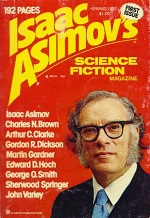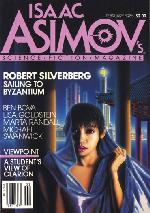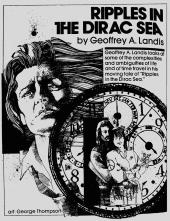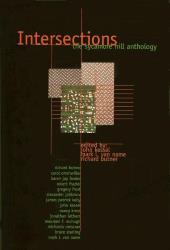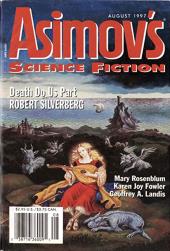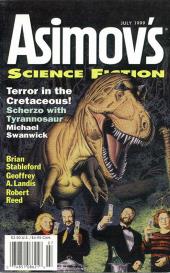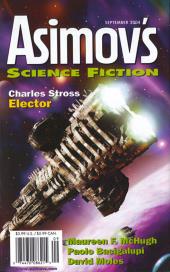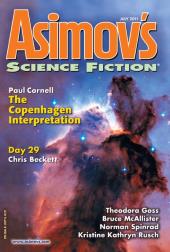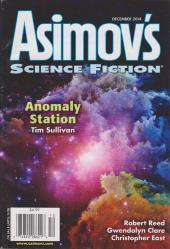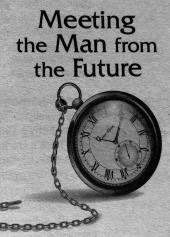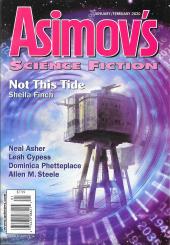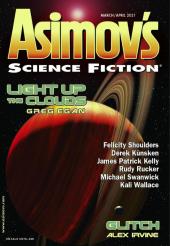Short Story
Asimov’s Science Fiction Magazine
Tag Area: Periodical
- Filter: Show all works, including those with no time phenomena.
- Found: 28 results in 14.83ms
Short Story
Air Raid
- by John Varley
- in Asimov’s Science Fiction, Spring 1977
Mandy snatches doomed people from the past in order to populate her war-decimated time. —none
I had to choose between a panic if the fathead got them to thinking, and a possible panic from the flash of the gun. But when a 20th gets to talking about his “rights” and what he is “owed,” things can get out of hand.

Short Story
Short Story
The River of Time
- by David Brin
- Isaac Asimov’s Science Fiction Magazine, May 1982
Daniel Brand, a science fiction writer, walks us through the new world where he lives that started when a large number of people seemingly froze in place. —Michael Main
Physicians listened to heartbeats that dragged on, lonely and deep, for over a minute per. They worried over eyes that refused to blink, yet remained somehow moist. They despaired over encephalograms whose spikes could be counted in single neuron flashes, adding up to a complex pattern that was . . . normal!

Short Story
Short Story
Sailing to Byzantium
- by Robert Silverberg
- Isaac Asimov’s Science Fiction Magazine, February 1985
Charles Phillips is a 20th-century New Yorker in a future world of immortal leisurites who reconstruct cities from the past. —Michael Main
He knew very little about himself, but he knew that he was not one of them. That he knew. He knew that his name was Charles Phillips and that before he had come to live among these people he had lived in the year 1984, when there had been such things as computers and television sets and baseball and jet planes, and the world was full of cities, not merely five but thousands of them, New York and London and Johannesburg and Parks and Liverpool and Bangkok and San Francisco and Buenos Ares and a multitude of others, all at the same time.

Novelette
The Pure Product
- by John Kessel
- in Asimov’s Science Fiction, March 1986
A cynical sociopath from the future goes on a crime spree (sometimes with random blood, sometimes with trite tripping on his future drugs) across 20th-century North America. —Michael Main
“I said, have you got something going,” she repeated, still with the accent—the accent of my own time.

Novelette
Short Story
Ripples in the Dirac Sea
- by Geoffrey A. Landis
- in Asimov’s Science Fiction, October 1988
A physics guy invents a time machine that can go only backward and must always return the traveler to the exact same present from which he left. —Michael Main

- Travel is possible only into the past.
- The object transported will return to exactly the time and place of departure.
- It is not possible to bring objects from the past to the present.
- Actions in the past cannot change the present.

Novelette
Novelette
Novella
The Hemingway Hoax
- by Joe Haldeman
- Isaac Asimov’s Science Fiction Magazine, April 1990
I’m from the future and the past and other temporalities that you can’t comprehend. But all you need to know is that yiou must not write this Hemingway story. If you do, I or someone like me will have to kill you.

Novelette
The Miracle of Ivar Avenue
- by John Kessel
- in Intersections: The Sycamore Hill Antholgy , edited by John Kessel et al., January 1996
In 1949 Los Angeles, Detective Lee Kinlaw has writer/director Preston Sturges down in the morgue. The only problem is that Sturges is still alive and well in Hollywood. —Michael Main
It’s a transmogrifier. A device that can change anyone into anyone else. I can change General MacArthur into President Truman, Shirley Temple into Marilyn Monroe.

Short Story
Standing Room Only
- by Karen Joy Fowler
- in Asimov’s Science Fiction, August 1997
On Good Friday in 1865, Anna Surratt pines for one of her mother’s boarders—a certain John Wilkes Booth—not knowing anything of Booth’s plans for the evening, her mother and brother’s possible role in those plans, or the reason for the legion of odd tourists packing the streets in the nation’s capital around Ford’s Theatre. —Michael Main
“It didn’t seem a good show,” Anna said to Mrs. Streichman. “A comedy and not very funny.”
Mrs. Streichman twisted into the space next to her. “That was just a rehearsal. The reviews are incredible. And you wouldn’t believe the waiting list. Years. Centuries! I’ll never have tickets again.” She took a deep, calming breath. “At least you’re here, dear. That’s something I couldn’t have expected. That makes it very real. [. . .]”
Short Story
Scherzo with Tyrannosaur
- by Michael Swanwick
- Asimov’s Science Fiction, July 1999
The director of Hilltop Research Station extinguishes various fires while hosting a donor dinner in the Cretaceous and planning predatory behavior of his own to keep the donor funds flowing, all while ensuring that the mysterious beings known only as the Unchanging remain in the dark about a quagmire of time travel violations. —Michael Main
It would bring our sponsors down upon us like so many angry hornets. The Unchanging would yank time travel out of human hands—retroactively.

Poem
Time Travel Verb Tenses
- by Laurel Winter
- Asimov’s (May 2000)
You remind me
of yourself at an age
you haven’t reached yet
Short Story
The Hat Thing
- by Matthew Hughes
- Asimov’s Science Fiction, September 2004
A nameless man tells another how to spot time travelers. —Michael Main
Sure. Researchers. Tourists. Criminals altering their present by manipulating the past. Religious pilgrims. Collectors. Who knows what motivates people in a million years from now?

Short Story
Pug
- by Theodora Goss
- in Asimov’s Science Fiction, July 2011
In the time of Napoleon, a sickly English girl discovers a dog in her garden, and the dog leads her through a door to other times and places. —Michael Main
(Imagine our relief to learn of Waterloo.)

Short Story
The Observation Post
- by Allen Steele
- in Asimov’s Science Fiction, September 2011
In 1962, Ensign Floyd Moore is the communications officer for the blimp Centurion patrolling the Caribbean for Russian shipments of nuclear missiles to Cuba. But what he and his lieutenant stumble upon on the larger Inagua island couldn’t possibly be Russian technology. —Michael Main
The world was on the brink of nuclear war, and no one knew it yet. Almost no one that, is.

Short Story
Videoville
- by Christopher East
- in Asimov’s Science Fiction, December 2014
In late 1986, geek Tim Stanek (he prefers the term “nerd”) and his high-school buddy Louis are approached one night by an unheard-of sort of person: a sensitive and inclusive football jock who asks them to come with him on a mission that needs their particular kind of resourcefulness. —Michael Main
AAPL, AMZN, GOOG, NFLX

Narrative Poem
Meeting the Man from the Future
- by Jane Williams
- Asimov’s Science Fiction, January/February 2020
We meet by chance one autumn evening

Novella
Not This Tide
- by Sheila Finch
- in Asimov’s Science Fiction, January/February 2020
Through the eyes of young Rosemary (in 1944 London during the time of buzz bombs and V-2 rockets) and old Rosemary (now called Mary in 2035 Oslo), we see the picture of her whole life from her imaginary friend during the war to her physicist grandson at Princeton. —Michael Main
Poem
Unlooping
- by Marie Vibbert
- Asimov’s Science Fiction January/February 2020
My life, a black vinyl record

Short Story
Dream Atlas
- by Michael Swanwick
- in Asimov’s Science Fiction, March/April 2021
Eleanor, a dream scientist, is visited by her future self in a vivid dream —Michael Main
Right now, all that matters is that within a month of your waking from this encounter, you’ll be able to duplicate thought projection through short durations of dream-time.

Short Story
Poem
Time Traveler at the Grocery Store circa 1992
- by Kristian Macaron
- Asimov’s Science Fiction, March/April 2021
Twentieth-century grocery store aisles provide a vision of a world of dust that's coming. —Michael Main
Some days it’s hard to believe that there’s not something wrong with the lettuce.

Short Story
The Dust of Giant Radioactive Lizards
- by Jason Sanford
- Asimov’s Science Fiction, September/October 2021
Forty years after NASA explorer Tessa Raij attempted to step through a dimensional portal and was instead relegated to an inexplicable state of isolation in a radioactivce crater, a dead girl—resembling her grandmother as a teen—shows up at her feet. —Michael Main
Anything entering her horizon no longer experienced the passage of time.

Novelette
Billie the Kid
- by Rick Wilber
- Asimov’s Science Fiction, September/October 2021
In an alternate history leading up to a 1945 atomic bomb in southern California, young Billie “the Kid” Davis grows up in the mid-20th century, playing shortstop better than any of the boys, flying B-25s with her Dad, and eventually—with Moe Berg and the woman-with-many-names—taking on that bomb. —Michael Main
This is your moment, Billie. Coming up right now. Save the worlds, Billie. Change everything. You can do it.


